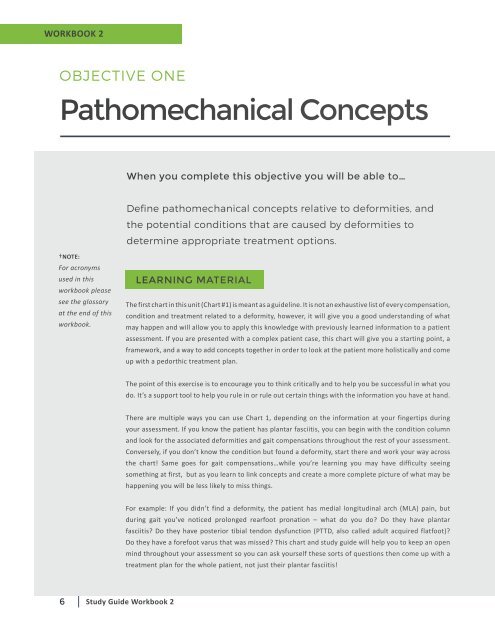OER - Pathomechanics, Conditions & Diseases
You also want an ePaper? Increase the reach of your titles
YUMPU automatically turns print PDFs into web optimized ePapers that Google loves.
WORKBOOK 2<br />
OBJECTIVE ONE<br />
Pathomechanical Concepts<br />
When you complete this objective you will be able to…<br />
Define pathomechanical concepts relative to deformities, and<br />
the potential conditions that are caused by deformities to<br />
determine appropriate treatment options.<br />
†NOTE:<br />
For acronyms<br />
used in this<br />
workbook please<br />
see the glossary<br />
at the end of this<br />
workbook.<br />
LEARNING MATERIAL<br />
The first chart in this unit (Chart #1) is meant as a guideline. It is not an exhaustive list of every compensation,<br />
condition and treatment related to a deformity, however, it will give you a good understanding of what<br />
may happen and will allow you to apply this knowledge with previously learned information to a patient<br />
assessment. If you are presented with a complex patient case, this chart will give you a starting point, a<br />
framework, and a way to add concepts together in order to look at the patient more holistically and come<br />
up with a pedorthic treatment plan.<br />
The point of this exercise is to encourage you to think critically and to help you be successful in what you<br />
do. It’s a support tool to help you rule in or rule out certain things with the information you have at hand.<br />
There are multiple ways you can use Chart 1, depending on the information at your fingertips during<br />
your assessment. If you know the patient has plantar fasciitis, you can begin with the condition column<br />
and look for the associated deformities and gait compensations throughout the rest of your assessment.<br />
Conversely, if you don’t know the condition but found a deformity, start there and work your way across<br />
the chart! Same goes for gait compensations…while you’re learning you may have difficulty seeing<br />
something at first, but as you learn to link concepts and create a more complete picture of what may be<br />
happening you will be less likely to miss things.<br />
For example: If you didn’t find a deformity, the patient has medial longitudinal arch (MLA) pain, but<br />
during gait you’ve noticed prolonged rearfoot pronation – what do you do? Do they have plantar<br />
fasciitis? Do they have posterior tibial tendon dysfunction (PTTD, also called adult acquired flatfoot)?<br />
Do they have a forefoot varus that was missed? This chart and study guide will help you to keep an open<br />
mind throughout your assessment so you can ask yourself these sorts of questions then come up with a<br />
treatment plan for the whole patient, not just their plantar fasciitis!<br />
6<br />
Study Guide Workbook 2


